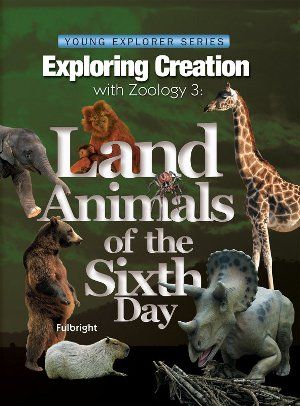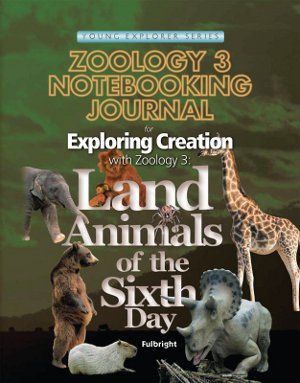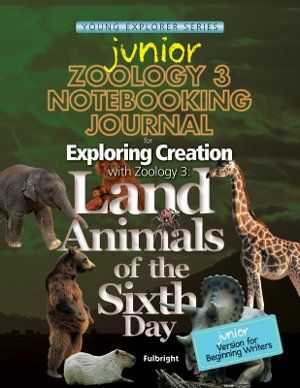
Apologia Educational Ministries has been known for many years in the homeschool community for its science curriculum. I have used the Botany program in the past and loved it. When I was selected to review Zoology 3: Land Animals of the Sixth Day I was thrilled. I was sent a copy of Zoology 3: Land Animals of the Sixth Day Textbook as well as a Notebooking Journal to review. I also purchased an additional Notebooking Journal and a Junior Notebooking Journal so that Tiger, Butterfly, and Pumpkin Pie would all have their own notebooks to work with.
Zoology 3 is an science text geared towards grades K-6. It is recommended that students complete Zoology 1 before continuing to Zoology 3, but it is not necessary. One reason to consider Zoology 1 first is to help students understand classification before delving into the study of land animals. If you choose not to do Zoology 1 first, you may wish to look at the sample of Zoology 1 in order to cover classifications first. Our family did not use Zoology 1 and we also didn’t use the sample. It has not been detrimental to my children. They were, however, familiar with classifications from Botany.
Unlike many animal texts, this one does not start with small animals like lizards and snakes. Instead, it starts with the wild beasts, moves into livestock and then finally animals that creep on the ground like worms, lizards and snakes. The reason the author has chosen the order of animal presentation is that the Bible lists wild animals first followed by livestock and then creatures that move along the ground in Genesis. Throughout the entire text the truth of God’s hand in the creation is shared.
The chapters tend to take a funnel approach by starting with a large groups of animals (order or family) and then moving towards the individual species. This funneling allows students to see how animals from the same family are the same and different. Each chapter also has extra learning opportunities like “What Do You Remember?” to give students a chance to narrate what they have learned, “Map It!” to have students to see where they primarily live, “Track It!” to learn about different animal tracks, notebooking activities, and experiments. Most of the experiments in Zoology 3 can be accomplished with items from the grocery store. The textbook also has a link and password to additional resources online listed at the front of the book. These resources include videos, pictures, charts, and articles for further study. For a comprehensive materials list for experiments, sample notebooking pages, a sample chapter, and table of contents be sure to check out the Apologia website.
Creating a notebook is an integral part of Apologia’s science curriculum. The notebook is “an important tool that will provide you and your child with a record of what was learned.” (Zoology 3, pg vi)While it is possible to use the textbook without the accompanying notebooks, I feel that both the Junior Notebooking Journal and Notebooking Journal make keeping the notebook so much easier for both me as the mentor and my children trying to keep track of all of their work. Each assignment within the text has a page in the notebook to complete as well as additional pages to record and round out the learning.
The junior notebook is geared towards younger elementary students (generally K-2) or those with limited writing abilities while the regular notebooking journal is geared towards middle to older elementary students (generally 3-6). Both journals contain a suggested outline for completing the curriculum as well as many resources to help the child create a meaningful notebook.
The Junior Notebook contains coloring pages, short notebooking assignments with large lines, places to draw pictures, activities, projects, book and DVD lists for each chapter geared for children under 8, copywork, some miniature colorful cut and fold books to add to the journal, and colorful animal stickers for the map assignments.
The Notebooking Journal has many similar features with a few modifications. There is more room for writing in the form of narration questions and a page for recording fascinating facts for each chapter. The lines provided are narrower for older writers. There are no coloring pages, but there are vocabulary crosswords, and a final 50 question review at the end of the notebook. The book and DVD lists include books and DVDs which are geared for children up to at least age 12.
We have been using Zoology 3 for part of our group learning time. I will read about half of a chapter aloud and we will discuss it. Tiger usually answers the “What do you remember?” questions while I am reading rather than waiting until later. I don’t mind, since he is gaining the valuable skill of note taking! Butterfly usually listens and then does all her notebooking work later. Meanwhile, Pumpkin Pie usually listens and colors one of the coloring pages in her notebook. The next day I read the other half and the process continues.
The children were really excited to stick the animal stickers from the backs of the notebooking journals on the wall map. As soon as they saw them, they couldn’t wait to use them. Strawberry really loved those stickers. She kept taking stickers from the various journals. Good thing we had enough to put on our maps! I was a little frustrated though that they were not labeled in the notebooks because some were hard to discern. In order to complete the map exercises, I chose to buy a very large wall map. We then used it to place pictures of the animals we talked about all around the world.
Tiger really liked the book lists and asked me to check out a few books from the book lists that interested him. I appreciated that each book listed has a brief synopsis as well as age recommendation.
Overall, we are really enjoying our study of land animals with Zoology 3. I believe children should not be talked down to or have information watered down for them. Yes, minute details might not need to be explored by young children, but I believe that they can handle scientific names, descriptions, and information. Land Animals teaches scientific information without dumbing it down. Furthermore, it presents it in a logical fashion which is easy for the children to understand. All of my school-aged children (6.5-11) are learning from this text at their own levels. None of them feel like it is too hard or too easy. This is especially important to me as I juggle so many ages, stages, and abilities with a limited amount of time. I look forward to continuing our science study and moving into another one of Apologia’s Zoology texts.
Apologia’s Zoology 3: Land Animals of the Sixth Day Textbook is available for $39, the Junior Notebooking Journal is available for $24, and the Notebooking Journal is available for $24.
Members of the Schoolhouse Review Crew reviewed all three zoology texts as well as the Anatomy and Physiology text. Be sure to check out their reviews by clicking the banner below.
Disclaimer: I received a free copy of this product through the Schoolhouse Review Crew in exchange for my honest review. I was not required to write a positive review nor was I compensated in any other way. All opinions I have expressed are my own or those of my family. I am disclosing this in accordance with the FTC Regulations.










This is a really excellent review! You gave such good solid details on the product and your photos were great fun!
ReplyDeleteThank you so much for putting your time and effort into this - it definitely shows! Great job!
Warmly,
Kate